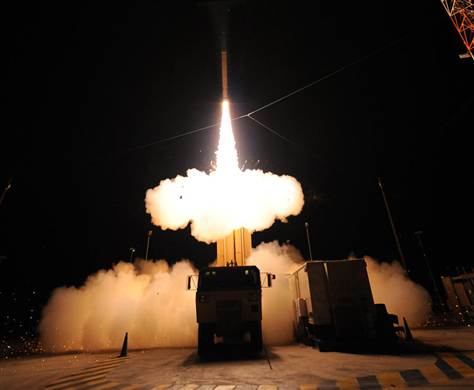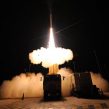
Deadlock On NATO-Russian Cooperation On European Missile Defense and a New Nuclear Arms Race (Part Two)
Publication: Eurasia Daily Monitor Volume: 8 Issue: 218
By:

On October 18, the US arms control expert, Steven Pifer offered an optimistic view on NATO-Russia relations and missile defense, while Russia’s Ambassador to the Alliance Dmitry Rogozin, outlined his own solution to the impasse over NATO’s refusal to legally guarantee that the phased adaptive approach would not lead to a system that could undermine the deterrence capabilities of Russia’s offensive nuclear forces. Rogozin’s proposal called for the joint development of a “strategic defense of earth system,” which would protect the earth not only from rocket attacks, but also from the threats of asteroids and other objects from space. Aleksandr Gabuev reported that President Dmitry Medvedev had expressed interest in the project. Rogozin sees his project as a basis for cooperation against a distant, but mutually recognized threat from outer space, while Russia rejects the idea that Europe faces any ballistic missile threats. Instead, common actions against threats from outer space would find resonance in US popular culture as in the case of the adventure film “Armageddon,” starring Bruce Willis. Other observers doubted that such a proposal would move the US away from European missile defense. Fyodor Lukyanov, the editor of “Russia in Global Politics,” discounted any impact the proposal would have in delaying US missile defense deployments in Eastern Europe (Kommersant, October 18).
One day later, the Russian press offered a very ambiguous perspective on progress toward a NATO-Russia deal on European missile defense. Ellen Tauscher, US Under Secretary of State for Arms Control and International Security, offered a non-binding statement saying the US did not intend European missile defense to challenge the deterrence capabilities of Russia’s strategic offensive nuclear arsenal. Roman Mamonov reported that Moscow and Washington were finally making progress in the discussions on European missile defense. He cited the statement by Tauscher that the missile defense system in Europe would not be directed against Russia. Mamontov read the declaration as the first step towards US concessions, including a binding legal document addressing that intent from the US (The Moscow Times, October 19).
On October 19, Vasily Vankov simply dismissed the document as a case of giving Russian diplomats something to read that they had already heard 1,000 times. Non-legally-binding declarations would not address official Russian concerns. There was still no evidence that Washington took seriously the Russian concerns over European missile defense. Progress on technical matters would not change the Russian perception that European missile defense in its final adaptive phases might not evolve into such a threat (www.km.ru, October 19).
On October 21, Foreign Minister Sergei Lavrov said that Russia saw no evidence of progress on NATO-Russia cooperation on European missile defense, because the US had declined to provide any legally-binding statement on the European missile defense system not being deployed against Russia (RIA Novosti, October 21). For the next ten days, the Russian government in one form or another repeated its warnings about the lack of progress on a Russia-NATO agreement on European missile defense. By October 25, Robert Bridge reported that President Medvedev had warned that failure to reach a deal on missile defense would lead to a new arms race. “In the coming decade we face the following alternatives… Either we reach agreement on missile defense and create a fully-fledged joint mechanism for cooperation, or…a new round of the arms race will begin” (Russia Today, October 25). One week later, Lavrov repeated his statement that no progress had been made on Russia-NATO cooperation in missile defense. Within a few days, the Russian press was full of accounts of the beginning of that very arms race. Lavrov declared: “The situation is serious and we will certainly raise this question during the coming contacts on the level of presidents of Russia and the US and the leaders of the leading NATO member states.”
Medvedev’s arms race became common knowledge, just one day before Lavrov’s statement. It began with a story in the United Kingdom by The Guardian, which proclaimed a new nuclear arms race was already underway. The British government, as part of its austerity program, has been cutting defense spending, while trying to find the means to maintain its nuclear triad. As part of the assessment process, the British American Security Information Council (BASIC) had created the Trident Commission to provide input on the debate about UK nuclear weapons policy, specifically on Trident renewal. The BASIC Trident Commission enjoyed the support of former senior defense experts from all major British political parties. Its first working paper by Ian Kerns highlighted the accelerated expenditures of other nuclear powers. The US and Russia plan to spend $700 billion and $70 billion respectively, on nuclear weapons and delivery systems over the next decade. The report also made the key point that some powers, notably Russia and Pakistan were shifting their invest strategy toward weapons and delivery systems that went beyond strategic deterrence and into war fighting. Others, especially the United States were pursuing conventional deep strike strategic systems (The Guardian, October 30).
The Russian media picked up the report immediately after its release. One day after the press coverage began on the BASIC report, the Russian media was already analyzing the report’s content to conclude that the world had embarked upon new round of the nuclear arms race with the United States, leading the race by the scale of its planned investment in such armaments over the next decade. Looking at Russia’s anticipated spending of $70 billion over the next decade, the author pointed to investments in new mobile, Lars-class solid-fueled missiles and in naval strategic nuclear systems, especially the development of the “Bulava” solid-fueled missile and the “Lainer” liquid-fueled, heavy missile, and the construction of eight “Borei” class SSBNs. The author further noted the long range development of the PAK DA nuclear-capable bomber, and a major investment in nuclear capable short-range Iskander missiles, which will number ten brigades by 2020 (Trud, October 31).
Follow-up articles explored other aspects of this new nuclear arms race. On November 1, lenta.ru addressed the reasons for the British report, and put it in the context of defense austerity and the rising costs of maintaining Britain’s own triad of nuclear forces. The article addressed the six major conclusions contained in the Kearns paper: the trend toward a reduction in nuclear arsenals, which began in the 1980s, has stopped and members of the nuclear club are now increasing their arsenals. Second, long-term modernization programs are leading to a new nuclear arms race. Third, all the states that have strategic nuclear arms see these as the necessary and vital means to achieve national security. Fourth, the programs of other nuclear powers are driving the modernization programs of others. In the case of Russia, US ballistic missile defense and conventional global strike systems have pushed Russian nuclear modernization. Fifth, the greater attention given to non-strategic nuclear forces by states with weaker conventional forces is a means of compensation for such weakness. And Sixth, Start III was a significant diplomatic achievement by the US and Russia, but it did not resolve a host of issues and will not serve as a brake on the developing nuclear arms race. The author concluded that Kearns’ report contained no surprises, but it did address the main trends in force development among the nuclear powers (www.lenta.ru, November 1).
Victor Litovkin reported on the Trident Commission paper, but then added comments from Aleksei Arbatov, which put a very different interpretation on the nuclear arms race. Arbatov characterized both US and Russian policy as modernization of arsenals of reduced size and stated that China was the only state with the economic and technological means to radically recast and expand its nuclear arsenal. Litovkin did note that the British debate was on extending the life of the Trident D5 missiles on Britain’s four SSBNs, which was a form of international cooperation on ballistic missile development, and Litovkin believes this places Britain and the United States in violation of the “International Code of Conduct against Ballistic Missile Proliferation” (Nezavisimaya Gazeta, November 2).
Litovkin followed this article with a second two days later. Arbatov’s observations were nowhere to be seen and the title emphasized a race in nuclear warheads. Now Litovkin stated that the British specialists had asserted that many members of the nuclear club were engaged in a race to perfect new nuclear weapons and delivery systems. Litovkin saw the US and Russia as the leaders in nuclear force modernization and outlined what each was doing to extend the life of their existing arsenals and to add new nuclear capabilities. Litovkin highlighted new ballistic missiles in India, China and Israel. The British report about foreign nuclear developments was supposed to contribute to Britain’s own debate about Trident renewal, which depended on US and UK cooperation (Nezavisimoye Voyennoye Obozreniye, November 4).
The past month has seen the final and inevitable collapse of any joint NATO-Russia solution to European missile defense. It has also witnessed the burial of Global Zero as a venue for the gradual reduction of the nuclear arsenals of the nuclear powers and the likely expansion of that community. Finally, it has confirmed the existence of a race to modernize nuclear arsenals, while at the same time increasing the probability of the use of non-strategic nuclear weapons by weaker powers in conventional conflicts as the last recourse in conflict management based upon the questionable assumption that such use will not lead to further escalation using strategic nuclear weapons. Sergei Karaganov, in writing to oppose Global Zero as a pipe dream, called strategic nuclear weapons the source of strategic stability and “that force, which wills evil and does good.” But Russians, unlike Germans, see the devil as having his own retinue. Mikhail Bulgakov may have used the phrase from Goethe’s Faust to begin Master i Margarita, but he gave Voland a retinue of little demons (melkie besy), whose action Voland did not always control. Let us hope that the melkie besy do not lead to untoward outcomes among the nuclear community.




